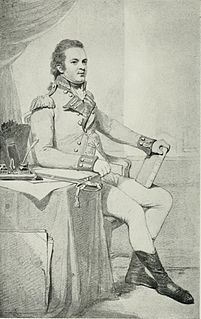
Lt. Col. Charles Mawhood was a British army officer during the 18th century, most noted for his command during the Battle of Princeton.

The Connecticut Line was a formation within the Continental Army. The term "Connecticut Line" referred to the quota of numbered infantry regiments assigned to Connecticut at various times by the Continental Congress, the size of its allocation determined by the size of its population relative to that of other states. These, together with similarly apportioned contingents from the other twelve states, formed the Continental Line. The concept was particularly important in relation to the promotion of commissioned officers. Officers of the Continental Army below the rank of brigadier general were ordinarily ineligible for promotion except in the line of their own state.

The New Hampshire Line was a formation within the Continental Army. The term "New Hampshire Line" referred to the quota of numbered infantry regiments assigned to New Hampshire at various times by the Continental Congress. These, together with similar contingents from the other twelve states, formed the Continental Line. The concept was particularly important in relation to the promotion of commissioned officers. Officers of the Continental Army below the rank of brigadier general were ordinarily ineligible for promotion except in the line of their own state.

The Rhode Island Line was a formation within the Continental Army. The term "Rhode Island Line" referred to the quota of numbered infantry regiments assigned to Rhode Island at various times by the Continental Congress. These, together with similar contingents from the other twelve states, formed the Continental Line. The concept was particularly important in relation to the promotion of commissioned officers. Officers of the Continental Army below the rank of brigadier general were ordinarily ineligible for promotion except in the line of their own state.
The Hillsborough District Brigade of militia was an administrative division of the North Carolina militia established on May 4, 1776. Brigadier General Thomas Person was the first commander. Companies from the eight regiments of the brigade were engaged in 55 known battles and skirmishes in North Carolina, South Carolina, and Georgia during the American Revolutionary War. It was active until the end of the war.

The 72nd Highlanders was a British Army Highland Infantry Regiment of the Line, raised in 1778. Under the Childers Reforms it amalgamated with the 78th (Highlanders) Regiment to form the 1st Battalion of the Seaforth Highlanders in 1881.

The 71st Regiment of Foot was a Highland regiment in the British Army, raised in 1777. Under the Childers Reforms it amalgamated with the 74th (Highland) Regiment of Foot to become the 1st Battalion, Highland Light Infantry in 1881.

Colonel John Drinkwater Bethune (1762–1844), born John Drinkwater, was an English army officer, administrator and military historian, known for his account of the Great Siege of Gibraltar that came out in 1785.

This is a list of auxiliary regiments or units formed by the British in individual colonies of the British Empire. In some colonies, the units were led by officers seconded from the British Army. Especially in the case of units that recruited non-whites, even in colonies where the officers were primarily colonials, commissions were generally restricted to whites until after the Second World War. Non-white colonials, as well as non-whites from Britain itself served primarily in the other ranks. Although militias operating on the same principle as the militia in England and Wales were established in many colonies during the 17th and 18th Centuries, from the 19th Century onwards colonial units were mostly voluntary, and supplied a reserve force either to be called up in war time to reinforce regular British Army garrisons for home defence, or in some cases were entirely responsible for home defence. Many units, however, took part in active campaigns outside of the role of home defence in various conflicts the British Empire was involved in, including the two world wars.
Francis North, 4th Earl of Guilford, styled The Honourable Francis North until 1802, was a British peer, Army officer, and playwright.
The 74th Regiment of (Highland) Foot or 74th Regiment of Foot was a British Army line infantry regiment from 1777 to 1784 which was raised to fight in the American Revolutionary War.
Catherine Upton was a poet and governess who was in Gibraltar during the time of the Great Siege (1779–1783). Her husband was Lieutenant John Upton of the 72nd Manchester Regiment. In 1787, she published The siege of Gibraltar, from the twelfth of April to the twenty-seventh of May, 1781, an account of life in Gibraltar during the first part of the Siege.
Five regiments of the British Army have been numbered the 72nd Regiment of Foot:
The 76th Regiment of Foot , sometimes referred to as 'MacDonnell's Highlanders' after its colonel, John MacDonnell of Lochgarry, was a Scottish Light Infantry regiment raised in the west of Scotland and western isles of Scotland in 1777.
The Edenton District Brigade was an administrative division of the North Carolina militia during the American Revolutionary War (1776–1783). This unit was established by the North Carolina Provincial Congress on May 4, 1776, and disbanded at the end of the war.
The New Bern District Brigade was an administrative division of the North Carolina militia during the American Revolutionary War (1776–1783). This unit was established by the North Carolina Provincial Congress on May 4, 1776, and disbanded at the end of the war.





